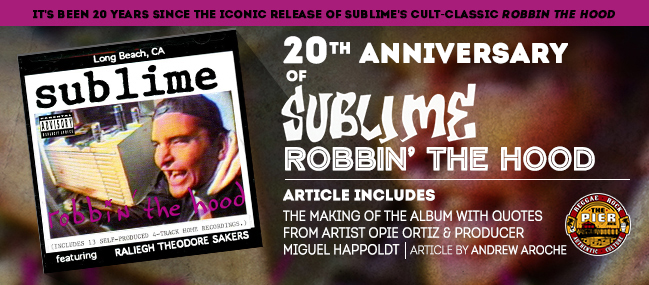
Sublime’s Robbin’ The Hood: 20th Anniversary
Release Date: March 1st, 1994
Record Label: Skunk Records/MCA Records & Gasoline Alley
Track Listing:
1.) Waiting For Bud
2.) Steady B Loop Dub
3.) Raleigh Soliloquy Pt. I
4.) Pool Shark
5.) Steppin’ Razor
6.) Greatest-Hits
7.) Free Loop Dub
8.) Q-Ball
9.) Saw Red
10.) Work That We Do
11.) Lincoln Highway Dub
12.) Pool Shark (Acoustic)
13.) Cisco Kid
14.) Raleigh Soliloquy Pt. II
15.) S.T.P.
16.) Boss D.J.
17.) I Don’t Care Too Much for Reggae Dub
18.) Falling Idols
19.) All You Need
20.) Freeway Time in L.A. County Jail
21.) Mary
22.) Raleigh Soliloquy Pt III (Hidden tracks: Don’t Push / Untitled / The Farther I go)
We can only speculate as to what Sublime Vocalist/Guitarist, Brad Nowell, would be doing if he were still around today. Perhaps he’d be touring, a sought after producer or maybe he’d be the president of his own record label. Heck, maybe he’d be retired somewhere in Jamaica, smoking joints with Snoop Dogg and Bunny Wailer. The world will never know unfortunately, but one thing’s for sure – He’d be calling us crazy for paying homage to Robbin’ the Hood.

Consisting of thirteen self-produced, 4-track home recordings and the psychotic ramblings of a mental patient named Raleigh Theodore Sakers, this album definitely wasn’t meant for the casual Sublime fan. Even the man on the cover of the album, Opie Ortiz admits, “For me, as an artist, when you listen to that album, you fucking get kind of scared and creeped out. You’re just like ‘what the fuck is this? This is dark, man.’” Despite its overall tone and lack of production value, Robbin’ the Hood holds a special place in the hearts of Sublime fans for it’s sheer rawness.
Following the release of their debut album 40oz. to Freedom in 1992, Sublime began to gain notoriety around southern California. Meanwhile, Brad was gaining notoriety around Long Beach for his growing addiction to heroin. By the time Sublime released Robbin’ the Hood in 1994, Brad was at the peak of his addiction.
“I only heard stories about what was going on at that time,” recalls Ortiz. “Miguel, I don’t know if he forced Brad or whatever, but he was like ‘dude we have to put this out.’ I think [Brad] wasn’t happy with it, you know what I mean? You come out strong with 40oz. and then go all raw, ‘fuck it.’ …I would say it was like Brad’s ‘hey I’m still out here’ release.”
Along with Brad’s addiction, there were other problems that factored into the style of the album. “With Robbin’ the Hood we were homeless, we had nothing,” recalls Sublime member & Skunk Records founder Miguel Happoldt.
The process of making this album was extremely difficult. The band was struggling financially, so much so that they designed the album layout at Kinko’s, where they were happy just spending the day in an air-conditioned building. The lack of money and studio time, along with the erratic behavior of their lead singer proved to be a burden, so they were forced to make do with what they had at their disposal.
“They would go to a pad in Costa Mesa that was like abandoned or some shit, like some tweaker pad. It was weird,” says Ortiz. It was there that the band wrote and recorded most of the songs on the album, including all the dubs and acoustic tracks, while songs like “STP” and “Greatest Hits” were recorded at Westbeach Recorders in Hollywood. There’s a notable difference in audio quality between songs, but perhaps most noticeably are the abrupt recordings of the mysterious Raleigh Theodore Sakers.
No one knows exactly where these recordings came from, or who he is for that matter, but whether you  listen and chuckle or skip through them, Raleigh’s recordings on Robbin’ the Hood emphasize the dark and strange, underground tone of the album. When asked about why the recordings were added, Miguel Happoldt said, “We just thought it would be funny to put it on there. Now, I kind of wish we didn’t because it’s just such a great album now, it’s probably a distraction.”
listen and chuckle or skip through them, Raleigh’s recordings on Robbin’ the Hood emphasize the dark and strange, underground tone of the album. When asked about why the recordings were added, Miguel Happoldt said, “We just thought it would be funny to put it on there. Now, I kind of wish we didn’t because it’s just such a great album now, it’s probably a distraction.”
There’s an old rumor that the recording was made by former drummer Kelly Vargas’ brother, but that can’t be confirmed since the band often avoided or lied about it’s origin. Opie, like many others, was thrown off by Raleigh’s recordings the first time he heard them, but he does have some insight as to where they came from: “I guess the guy was somewhere around here because he says the address at one point and one of my friends was like ‘I know exactly where that’s at.’ It was like some psycho house.”
It’s pretty much safe to say that everyone who held Robbin’ the Hood in their hands for the first time immediately thought it was strange. For starters, it’s the only original Sublime release that doesn’t feature Opie Ortiz’s artwork on the cover. Instead, there’s a rather unflattering image of his face taken from the music video for “STP,” which didn’t go over well initially. “I wasn’t down with it at first” says Ortiz. “Miguel told me there were only gonna be a thousand made. But that was a rough time for me, I had just gotten my teeth knocked out and shit. I had this weird bridge thing that you wear and Brad was like ‘dude don’t wear that fucking thing,’ and I just haven’t gotten them fixed since.”
Just like the addition of the Raleigh soliloquies, Miguel chose the album cover for a simple reason; it was funny. “It was new science at the time to make stills from video. So [Greg Abramson] had made a bunch of them and he just brought them over to the house. I think when we were at Kinkos, all of us probably just laughed and put it on there” says Miguel. The album booklet also features two drawings from Opie’s sketchbook that he wanted to refine at first, but now admits that they tie in perfectly with the album’s overall style.
Even with an early appearance from No Doubt’s Gwen Stefani, Robbin’ the Hood didn’t produce any hit singles, but many of Sublime’s most memorable songs have their roots in this album. “Brad’s an artist, but he was on another level of writing. It wasn’t like he wrote a song and it was done. When he wrote a song it became this other song, and then parts of it became another song. He was constantly creating, you know? Everything that went in his ear is what he wrote about,” says Ortiz. 
The line, “Music from Jamaica all the love that I’ve found, pull over there’s a reason why my soul’s unsound” is heard for the first time in “Steady B Loop Dub,” which was later used in “Garden Grove.” There’s also an early instrumental version of “Santeria” called “Lincoln Highway Dub,” but perhaps the most memorable song on this album is “Pool Shark,” A haunting description of Brad’s struggle with heroin.
“For me, this is one of my favorite albums, not because I’m on the cover, but because it’s not all over produced,” says Ortiz. “It’s not all ‘oh, let’s make this band super-duper’ you know? This is Sublime at its rawest.”
It isn’t enough for mankind to climb mountains, we need to do it with the fewest amount of tools in order to feel accomplished. Even though this album didn’t enjoy any mainstream success, it accomplished something that few musicians ever do, and with far less money. It shows a man in his most vulnerable state, singing with such a profound sense of emotion that every word that comes out of his mouth allows the listener to experience these emotions with him. It takes us back to the fundamentals of music.
Sublime is arguably one of the most innovative bands in history because it incorporated different genres of music into a level of success like no other band before it. Even though Brad Nowell gets most of the credit for this innovation, we can’t forget about the other creative forces behind the signature Sublime style. Bud Gaugh, Eric Wilson, Marshall Goodman, Todd Foreman, Miguel Happoldt, Opie Ortiz and Kelly Vargas’ influence on Brad and the band helped bring Sublime to new creative heights, particularly with this album.
Robbin’ the Hood blends light and dark with a great deal of simplicity, but that raw simplicity is what makes it so special. While it may not be the crown jewel of the Sublime collection, we can all love and appreciate the sound of the real Brad Nowell, which is so nice that we’ll gladly hear it twice.
Related Links:
Exclusive Sublime Blog
Opie Ortiz Exclusive Interview Pt 1
Opie Ortiz Exclusive Interview Pt 2
Marshall Goodman Exclusive Interview Pt 1
Marshall Goodman Exclusive Interview Pt 2
Miguel Happoldt Exclusive Interview Pt 1
Miguel Happoldt Exclusive Interview Pt 2
Article By: Andrew Aroche
Photos By: David Norris
Watch: Sublime – “STP”

